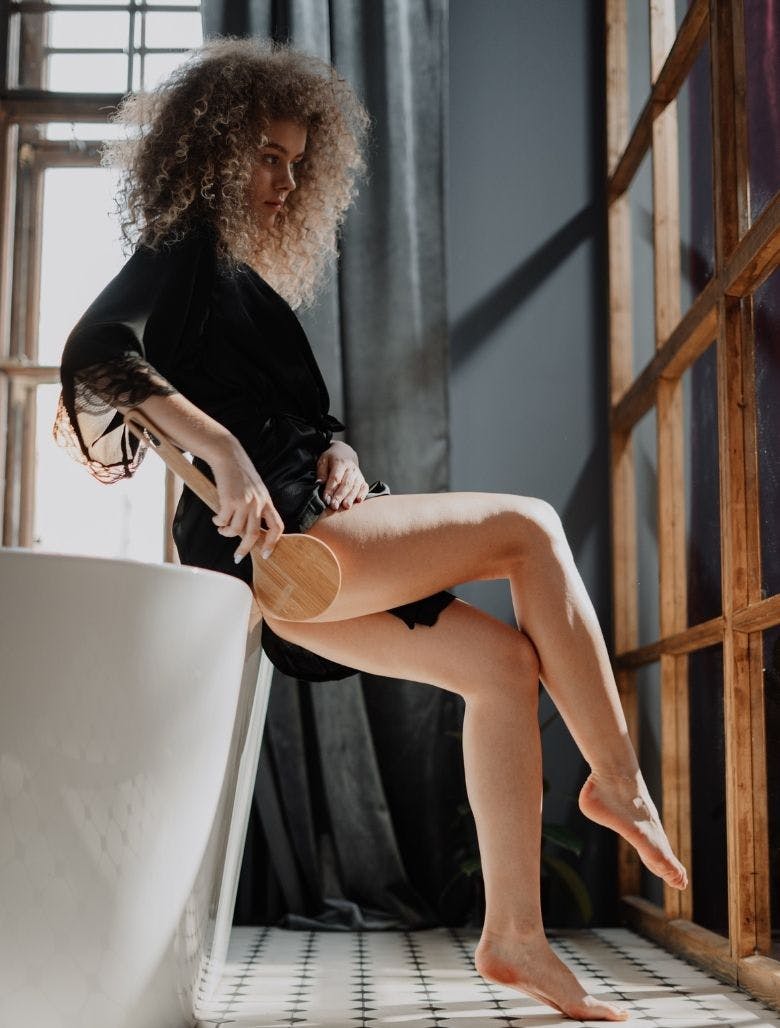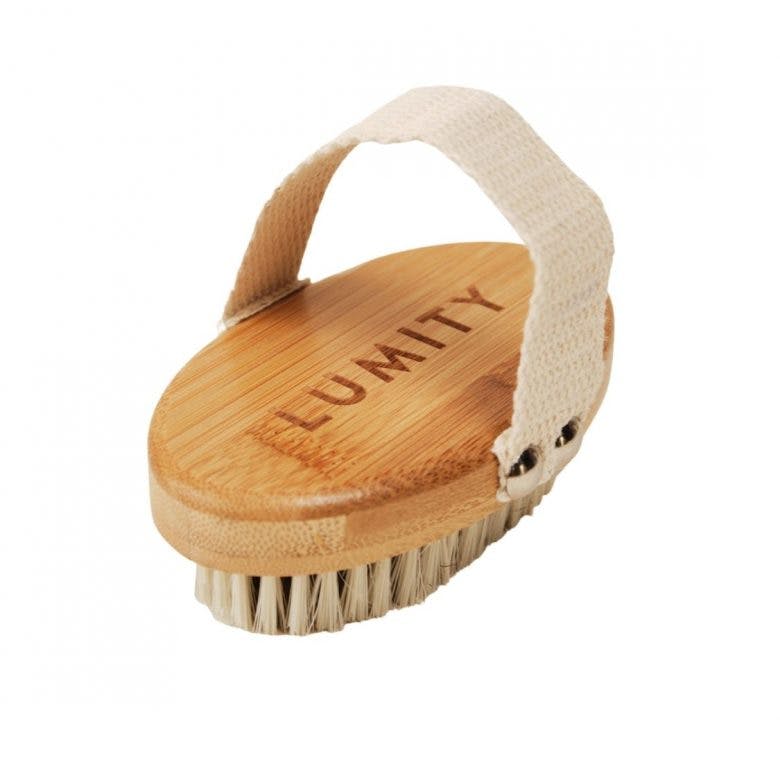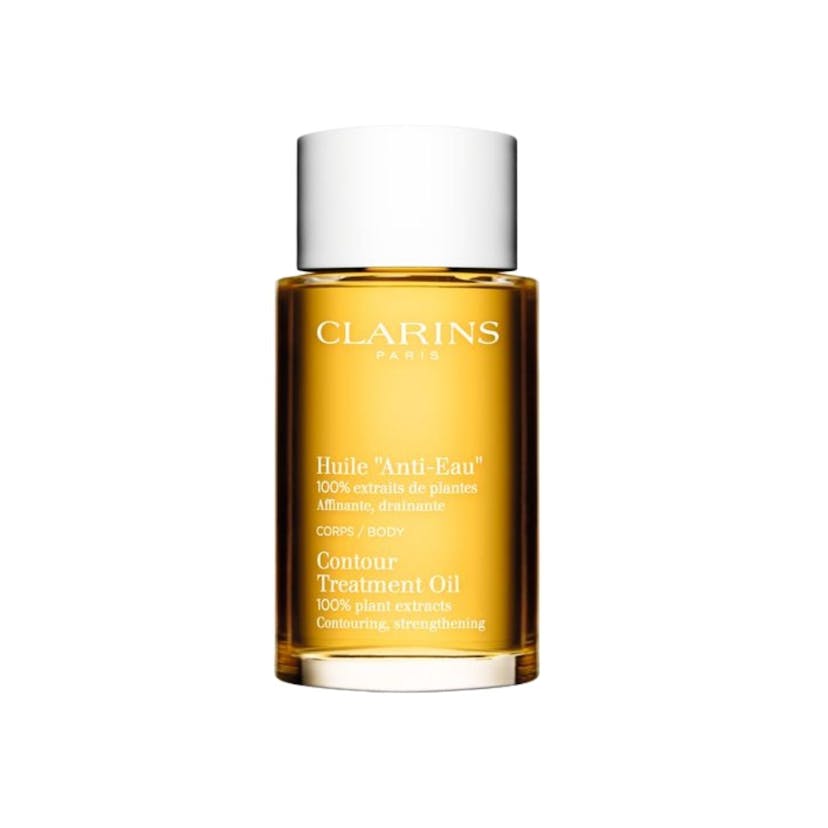What Is Dry Body Brushing And What Are The Benefits?
6 minutes read
Dry brushing is one of those wellness trends celebrities and skincare experts swear by.
It is a body glow-up technique that heavily relies on two things: a soft but firm bristle brush and specific massage movements. Its claimed benefits? Reduced cellulite appearance, flushed body toxins and improved skin complexion in just minutes.
Unsure how to dry brush? Beauty Daily sat down with Uma Ghosh, holistic beauty educator and Co-Founder of Pro-Age Aesthetics Academy, and Sarah Murray, Director and Advanced Therapist at Sarah Murray Beauty and Skin Clinic, to explain everything you need to know. From the latest dry brushing techniques and how to do it correctly so you can reap the benefits.
What is dry brushing?
Dry brushing, interchangeably called skin or body brushing, is an age-old technique used for centuries. It is an exfoliating body massage that uses natural-fibre bristles in a particular pattern on dry skin.

Benefits of dry brushing
There is little scientific evidence to support the benefits of dry brushing, but there’s no harm, and it’s worth a try.
Dry brushing has gained traction for a reason. The list of potential benefits includes:
1. Reduced appearance of cellulite.
One of the most mentioned results of dry brushing is reduced cellulite appearance.
Experts suggest that this is only a temporary visual result of the practice due to the increased blood circulation from dry brushing, which causes vasodilation (widening of your blood vessels). This causes a temporary plumping of the skin, making cellulite appear less visible.
However, some experts believe that when dry brushing is performed correctly and consistently, it can visibly reduce the appearance of cellulite.
Read next: Your Guide To Understanding And Treating Cellulite
2. Improved skin radiance
Due to its exfoliation benefits, dry brushing improves skin appearance by shedding dull and dead skin cells and revealing new and healthy skin cells. This will give you soft and smooth skin temporarily.
3. Stimulation of the lymphatic system
Lymph fluid can build up and cause swelling if it is not drained. This is where dry brushing comes in handy, as it may help speed up the removal of waste and toxins from the body. In addition, dry brushing movement stimulates the lymphatic system to move fluid around the body more effectively, ensuring it doesn’t get clogged anywhere.
This results in less puffiness and water retention, reduction in swelling and toned and firm skin.
Read next: Does Lymphatic Drainage Massage Actually Work? Experts Weigh In
4. Stress relief aid
Ghosh, who has half a million subscribers on her beauty Youtube Channel The Uma Show, says: “A wellness benefit of dry brushing is it promotes relaxation and aids stress relief. The act of dry brushing can stimulate the skin and help release tension throughout the body without a hard massage option. Followed with a warm, steamy shower can also help relieve any tension or anxiety.”
How many times a week do you need to dry brush?
Dry brushing can be done everyday or every other day from five to ten minutes.
Most experts recommend dry brushing in the morning because of its energising qualities. However, the best time depends on your lifestyle and whether it fits your self-care or me-time schedule.
“Consistency is key. Use it daily or as often as your skin will allow. Body brush before you shower in the morning and keep water intake high to keep the body hydrated and flush out toxins and waste,” says Sarah Murray, Director and Advanced Therapist at Sarah Murray Beauty and Skin Clinic.
However, if you have very dry or sensitive skin – it might be worth keeping it to 2-3 times per week.
How do you dry brush?
Word of caution: Experts strongly recommend not using a dry brush on skin that’s ‘broken,’ such as cuts, scrapes, lesions, sores, or sunburns. If you have sensitive skin or a skin condition, such as psoriasis, speak with your doctor before dry brushing.
Tools:

You’ll want to use a natural stiff-bristled bath or shower brush. Beauty Daily recommends this Copper Body Brush from Lumity.
This body brush has natural bristles with copper wires designed to help effectively detoxify the body and improve lymphatic drainage. With regular use, skin is left smooth and dead cells are buffed away to reveal a healthier, radiant skin.
If you fancy a long handle body brush, this Oval Bamboo Body Brush from The White London will also help to slough hard-to-reach places.
Oils:
Some people use the brush on its own; others put a bit of body oil on the brush before they use it.
“You can body brush dry skin or use oil. If you have sensitive or dry skin you may want to apply oil to the skin first and start gently and build pressure,” says Murray.
Ghosh shares: “What I do is after dry brushing, I apply oil and do Gua Sha or wooden massager.”
Oils are an excellent way to add nutrients to your skin. Listen to what your skin needs and address accordingly – there are oils that target specific skin concerns like dryness, cellulite, stretch marks and water retention.
Beauty Daily recommends three aromatherapy infused body oils:

- Contour Treatment Oil to help eliminate body toxins and reduce puffiness and swelling.
- Tonic Treatment Oil to tone, firm, and improve skin’s elasticity, smoothing the appearance of stretch marks.
- Relax Treatment Oil to soothe tired and tensioned muscles and promote a sense of calm and relaxation.
Procedure:
- Begin from your feet, lower legs, thighs, and torso. Work upwards towards the heart with long movements.
- Use firm, small strokes upward, or work in a circular motion; this will help move the lymph fluids.
- For the stomach, work in a clockwise direction.
- Move from your forearms to your upper arm.
Things to remember when dry brushing
1. Perform this when standing in the shower or bath before the water is running.
Keep it neat and tidy. You want to be where the dry skin is contained and can be removed from the area easily.
Do you have to shower after dry brushing? Yes.
Experts recommend taking a shower right after dry brushing to remove the extra skin the brush may have not removed.
“It will also serve as a method to clean the pores and rejuvenate the cells. If you do not want to shower, you can choose to take a warm bath instead. As long as one or the other follows the dry skin brushing,” Ghosh says.
2. Brush your entire body
Which part of your body needs dry brushing? All of it! For the bust and other sensitive areas of the body, caution is needed.
Ghosh instructs: “All you need to do is brush lighter in these areas, but do not avoid them. You need to remove the dry skin from every area of your body to help skin cell turnover and keep the skin looking its best.”
3. Alternate your water temperature
One aspect of the dry brushing method that you may not consider is the water temperature you use after the procedure.
“Opt for a gradual decrease in water temperature from hot to cold. This is done to open your pores and then close them, getting them cleaned and then tightened to help with the appearance of cellulite,” Ghosh suggests.
After your dry brushing session, Murray recommends moisturising.
Beauty Daily recommends slathering emollient-rich, shea butter body lotion like the Moisture-Rich Body Lotion.
There you have it, simple steps to start your daily dry brushing routine. Feel free to add or tweak several steps along the way. Listen to your skin and body’s needs, and most importantly, have fun! Want to know how to layer your body skincare products? Read this.
Sign up for our newsletter
We will keep you in the loop for special offers, exclusive gifts and product news.

